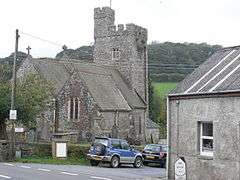Llanddowror
Llanddowror is a village and a community in Carmarthenshire, Wales situated 2 miles (3 km) from St. Clears. Previously on the trunk road to Pembroke Dock, the village is small, historic and relatively unspoilt.
| Llanddowror | |
|---|---|
 St Teilo's Church (2008) | |
| Population | 851 (2011)[1] |
| OS grid reference | SN254144 |
| Community |
|
| Principal area | |
| Ceremonial county | |
| Country | Wales |
| Sovereign state | United Kingdom |
| Post town | CARMARTHEN |
| Postcode district | SA33 |
| Dialling code | 01994 |
| Police | Dyfed-Powys |
| Fire | Mid and West Wales |
| Ambulance | Welsh |
| UK Parliament | |
| Senedd Cymru – Welsh Parliament |
|
Llanddowror is famous for being the home of its rector, Griffith Jones, the 18th century Anglican educator and promoter of Methodism, who was funded by Bridget Bevan in organising circulating schools to spread literacy in Carmarthenshire.[2]
The community is bordered to the south by Carmarthen Bay and inland with the communities of Pendine, Eglwyscummin, St Clears and Laugharne Township.
Amenities
A new bypass improvement scheme for the section of the A477 trunk road between St Clears and Red Roses was approved by the Welsh Government on 27 January 2012. Construction work on the new bypass began in mid-2012.[3] Constructed with a straighter alignment and bypassing the villages of Llanddowror and Red Roses, the new section was scheduled to open during May 2014[4] but opened to general traffic at around 12:25 pm on 16 April 2014 having previously been declared open earlier in the day by Edwina Hart, Welsh Assembly Member for Transport.[5][6]
Rental holiday cottages and bed & breakfast locations are available in Llanddowror. A local attraction is the nearby ruin of the Norman castle in St Clears.
Imperial Legacy
Llanddowror has lent its name to the British Raj-era hill station of Landour in the Lower Western Himalaya in northern India. Landour was founded in 1827 as a convalescent station for British soldiers serving in India. During British colonial rule, nostalgic British names were common in India and many of these names survive today although many others were discarded once India became an independent state.[7]
References
- "Community population 2011". Retrieved 14 April 2015.
- https://www.bbc.co.uk/blogs/wales/entries/687b3cfb-779d-3885-9610-652c384b6f06
- A477 Red Roses St Clears Improvement Scheme
- https://twitter.com/A477SCRR/status/423121289952251904/photo/1
- "Section of A477 officially opens after £68m upgrade". ITV News Wales. 16 April 2014. Archived from the original on 17 April 2014. Retrieved 17 April 2014.
- "£68million improvements to A477 brings benefits to the economy, tourism and local communities". Welsh Government News. 16 April 2014. Archived from the original on 17 April 2014. Retrieved 17 April 2014.
- Jalil, Rakhshanda (14 July 2012). "Mussoorie blues". The Hindu. Retrieved 1 March 2017.